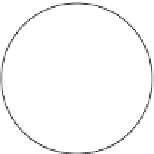Biomedical Engineering Reference
In-Depth Information
1.(a) STEP INDEX
MATCHED CLADDING
CONVENTIONAL UNSHIFTED
(1.3
μ
m) PROFILE
1.(b) STEP INDEX
DEPRESSED CLADDING
DISPERSION SHIFTED
(1.55
m) PROFILE
μ
2.TRIANGULAR INDEX
MATCHED CLADDING
3.MULTIPLE LAYER
DESIGN
DISPERSION FLATTENED
PROFILE
Figure 6.2-14 Profile shapes of different types of single-mode fibers.
6.2.3 Analysis of optical fibers
(
6.2.2
)] shown later for
E
z
and
H
z
in both the core and
cladding regions of the fiber:
6.2.3.1 The step-index fiber
v
2
E
z
v
2
E
z
vr
2
þ
1
vE
z
vr
þ
1
v
f
2
þ
k
2
E
z
¼
0
(6.2.1)
r
r
2
In this section electromagnetic field theory will be used
to solve rigorously the boundary value problem of the
round optical fiber with a homogeneous core (the step-
index fiber) (
Morse and Feshbach 1953
). To simplify this
analysis, we will assume that the fiber is oriented along
the
z
axis and the radius
b
of the fiber cladding is large
enough to ensure that the cladding field decays expo-
nentially and approaches zero at the cladding-air in-
terface. This allows us, as shown in
Figure 6.2-15
,to
analyze the fiber as a tractable two-media boundary value
problem. This thick-cladding assumption agrees well
with the conditions that exist within a properly designed
optical fiber used for communication purposes. The steps
that we will follow to solve the boundary value problem
of the step-index fiber are outlined in
Table 6.2-3.
To
obtain the modes in a step-index optical fiber, one must
solve the modified wave equation [Eqs. (
6.2.1
) and
v
2
H
z
v
2
H
z
vr
2
þ
1
vH
z
vr
þ
1
v
f
2
þ
k
2
H
z
¼
0
(6.2.2)
r
r
2
Having obtained expressions for
E
z
and
H
z
, we can di-
rectly obtain from Maxwell's equations expressions for
the transverse components of the fields:
E
r
¼
j
k
2
b
vE
z
vr
þ
um
1
vH
z
v
f
(6.2.3)
r
E
f
¼
j
k
2
b
1
r
vE
z
v
f
um
vH
z
(6.2.4)
vr
Table 6.2-3 Analysis of the step-index fiber procedures followed
1. Mathematically model the step-index fiber using the wave
equation in cylindrical coordinates.
Core-Cladding Boundary
2. Use the technique of separation of variables to partition the
wave equation.
Air-Cladding Boundary
3. Define the physical requirements that influence the solution of
the fields in the core and cladding.
a
n
1
r
STEP-INDEX FIBER
n
2
4. Select the proper functional form of the solution of the
modified wave equation (Bessel's equation) in the core and
cladding.
Core-Cladding Boundary
b
a
Geometry of Model
Used to Analyze
Step-Index Fiber
5. Apply the boundary conditions at the core-cladding interface.
r
n
1
6. Obtain the ''characteristic'' equation and its resulting modal
equations.
b
→∞
n
2
7. Analyze the resulting modes and their cutoff conditions.
Figure 6.2-15 Physical characteristics of step-index fibers.













































